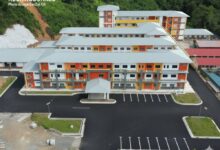Places to visit in Kuching: The Colonial Heritage Sites

Kuching has over the years retained much of it’s colonial buildings and restored them to perfection with the Kuching Waterfront itself showing off rows of shop houses which dates way back to the Brooke eras.
For tourist loving historical buildings, here’s a list of some of the colonial-era heritage buildings Kuching has to offer.
The Bishop’s House – The private residence of the Anglican Bishop of Kuching, and therefore not a building generally open to the public, this colonial gem features the classic white walls and exposed woodwork associated with Tudor England. Completed in 1849, the Bishops House is thought to be the oldest European-style dwelling in Sarawak. Read more here.
The Astana – The official residence of the governor of Sarawak, the Astana or “istana”, meaning palace, was built in 1870 by Charles Brooke, the second White Raja, as a gift to his bride Margaret Lili Alice de Windt. Though the building itself is not generally open to the public, its gardens are accessible via a boat ride across the Sarawak River. The Astana is made up of three buildings and resembles a castle with its square towers and long sloping roofs.
Kuching Courthouse – Built by Charles Brooke in 1883 on the waterfront to house government offices and ceremonies, the courthouse incorporates Ancient Greek columns, wooden walkways, large sloping roofs and a baroque clock tower into a pastiche of colonial styles. It is now home to the Sarawak Tourism Complex.
Fort Margherita – Also built by the second Raja in 1879 to protect Kuching from pirate attacks from the Sarawak River, the fort resembles an English castle. Located near the Astana, Fort Margherita is now a tourist attraction.
Round Tower – Resembling a fortress with its round turrets and white walls, but in fact used as a town dispensary after a fire ravaged the area, the Round Tower was constructed in 1886. It is home to the Sarawak Handicraft Centre and is open daily 9am-6pm with free admission.
Sarawak State Museum – Established in 1888 and sponsored by Charles Brooke at the behest of naturist Alfred Wallace, this is the oldest museum in Borneo. The museum features a Queen Anne style of architecture and houses ethnographic exhibits and items documenting the natural history of Sarawak.
Pavilion Building – this three story architectural gem is located within the Old Courthouse complex and houses the Sarawak Textiles Museum, which showcases local ethnic costumes and information about Sarawak’s textile process. The building was constructed as a medical centre in 1909 in a mix of English Colonial and Renaissance styles.
St. Joseph’s Boys School (1894) and St. Thomas’s Boys School (1886) – A pair of religious schools, the first Catholic and the second Anglican, document the missionary history of Sarawak, which began in 1848.
Kuching General Post Office Building – The most recent example of colonial architecture, this imposing Neo-Classical structure dates from 1931 and features Corinthian columns, a facade composed of many arched openings and a central cornice. The Post Office stands opposite the Textile Museum (Pavilion Building).
Tua Pek Kong Temple – One of the city’s oldest temples, this elaborate Chinese structure dates from 1843 and is located right smack dab in the middle of Kuching’s historic centre.
Chinese History Museum – Built in classical-colonial style in 1912 as the Chinese Chamber of Commerce on the instructions of Charles Brooke, this museum showcases the history of the different Chinese communities in Sarawak. Admission is free and opening hours are 9am-6pm (closed Fridays).
Data obtained from an article written by Graham Land. If you want to stay in a hotel nearby these site, check out Hotels near the historical side of Kuching.





